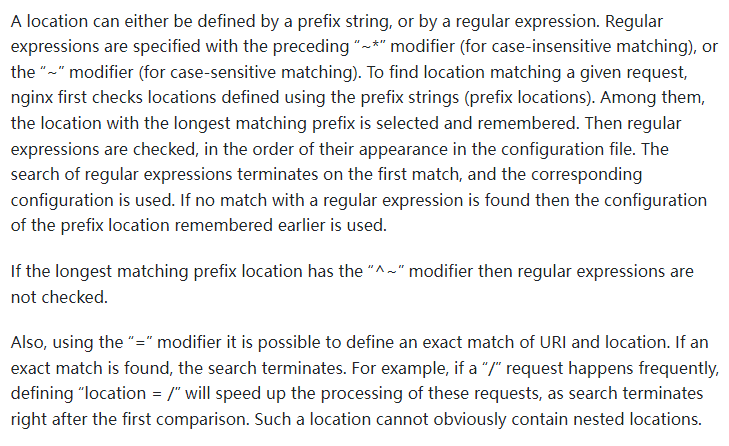еүҚиЁҖ
Location жҳҜ Nginx дёӯдёҖдёӘйқһеёёж ёеҝғзҡ„й…ҚзҪ®пјҢиҝҷзҜҮйҮҚзӮ№и®Іи§ЈдёҖдёӢ Location зҡ„й…ҚзҪ®й—®йўҳд»ҘеҸҠдёҖдәӣжіЁж„ҸдәӢйЎ№гҖӮ
иҜӯжі•
е…ідәҺ LocationпјҢдёҫдёӘз®ҖеҚ•зҡ„й…ҚзҪ®дҫӢеӯҗпјҡ
http {
server {
listen 80;
server_name www.yayujs.com;
location / {
root /home/www/ts/;
index index.html;
}
}
}
еӨ§иҮҙзҡ„ж„ҸжҖқжҳҜпјҢеҪ“дҪ и®ҝй—® www.yayujs.com зҡ„ 80 з«ҜеҸЈзҡ„ж—¶еҖҷпјҢиҝ”еӣһ /home/www/ts/index.html ж–Ү件гҖӮ
жҲ‘们зңӢдёӢ Location зҡ„е…·дҪ“иҜӯжі•пјҡ
location [ = | ~ | ~* | ^~ ] uri { ... }
йҮҚзӮ№зңӢж–№жӢ¬еҸ·дёӯзҡ„ [ = | ~ | ~* | ^~ ]пјҢе…¶дёӯ | еҲҶйҡ”зҡ„еҶ…е®№иЎЁзӨәдҪ еҸҜиғҪдјҡз”ЁеҲ°зҡ„иҜӯжі•пјҢе…¶дёӯпјҡ
- = иЎЁзӨәзІҫзЎ®еҢ№й…ҚпјҢжҜ”еҰӮпјҡ
location = /test {
return 200 "hello";
}
# /test ok
# /test/ not ok
# /test2 not ok
# /test/2 not ok
* ~ иЎЁзӨәеҢәеҲҶеӨ§е°ҸеҶҷзҡ„жӯЈеҲҷеҢ№й…ҚпјҢжҜ”еҰӮпјҡ
```bash
location ~ ^/test$ {
[ configuration ]
}
# /test ok
# /Test not ok
# /test/ not ok
# /test2 not ok
- ~* иЎЁзӨәдёҚеҢәеҲҶеӨ§е°ҸеҶҷзҡ„жӯЈеҲҷеҢ№й…Қ
location ~* ^/test$ {
[ configuration ]
}
# /test ok
# /Test ok
# /test/ not ok
# /test2 not ok
- ^~ иЎЁзӨә uri д»ҘжҹҗдёӘеӯ—з¬ҰдёІејҖеӨҙ
location ^~ /images/ {
[ configuration ]
}
# /images/1.gif ok
иҖҢеҪ“дҪ дёҚдҪҝз”ЁиҝҷдәӣиҜӯжі•зҡ„ж—¶еҖҷпјҢеҸӘеҶҷ uri зҡ„ж—¶еҖҷпјҡ
/ иЎЁзӨәйҖҡз”ЁеҢ№й…Қпјҡ
location / {
[ configuration ]
}
# /index.html ok
location /test {
[ configuration ]
}
# /test ok
# /test2 ok
# /test/ ok
еҢ№й…ҚйЎәеәҸ
еҪ“еӯҳеңЁеӨҡдёӘ location зҡ„ж—¶еҖҷпјҢ他们зҡ„еҢ№й…ҚйЎәеәҸеј•з”Ё Nginx е®ҳж–№ж–ҮжЎЈе°ұжҳҜпјҡ

зҝ»иҜ‘ж•ҙзҗҶеҗҺе°ұжҳҜпјҡ
location зҡ„е®ҡд№үеҲҶдёәдёӨз§Қпјҡ
- еүҚзјҖеӯ—з¬ҰдёІпјҲprefix stringпјү
- жӯЈеҲҷиЎЁиҫҫејҸпјҲregular expressionпјүпјҢе…·дҪ“дёәеүҚйқўеёҰ ~* е’Ң ~ дҝ®йҘ°з¬Ұзҡ„
иҖҢеҢ№й…Қ location зҡ„йЎәеәҸдёәпјҡ
- жЈҖжҹҘдҪҝз”ЁеүҚзјҖеӯ—з¬ҰдёІзҡ„ locationsпјҢеңЁдҪҝз”ЁеүҚзјҖеӯ—з¬ҰдёІзҡ„ locations дёӯйҖүжӢ©жңҖй•ҝеҢ№й…Қзҡ„пјҢ并е°Ҷз»“жһңиҝӣиЎҢеӮЁеӯҳ
- еҰӮжһңз¬ҰеҗҲеёҰжңү = дҝ®йҘ°з¬Ұзҡ„ URIпјҢеҲҷз«ӢеҲ»еҒңжӯўеҢ№й…Қ
- еҰӮжһңз¬ҰеҗҲеёҰжңү ^~ дҝ®йҘ°з¬Ұзҡ„ URIпјҢеҲҷд№ҹз«ӢеҲ»еҒңжӯўеҢ№й…ҚгҖӮ
- 然еҗҺжҢүз…§е®ҡд№үж–Ү件зҡ„йЎәеәҸпјҢжЈҖжҹҘжӯЈеҲҷиЎЁиҫҫејҸпјҢеҢ№й…ҚеҲ°е°ұеҒңжӯў
- еҪ“жӯЈеҲҷиЎЁиҫҫејҸеҢ№й…ҚдёҚеҲ°зҡ„ж—¶еҖҷпјҢдҪҝз”Ёд№ӢеүҚеӮЁеӯҳзҡ„еүҚзјҖеӯ—з¬ҰдёІ
еҶҚжҖ»з»“дёҖдёӢе°ұжҳҜпјҡ
еңЁйЎәеәҸдёҠпјҢеүҚзјҖеӯ—з¬ҰдёІйЎәеәҸдёҚйҮҚиҰҒпјҢжҢүз…§еҢ№й…Қй•ҝеәҰжқҘзЎ®е®ҡпјҢжӯЈеҲҷиЎЁиҫҫејҸеҲҷжҢүз…§е®ҡд№үйЎәеәҸгҖӮ
еңЁдјҳе…Ҳзә§дёҠпјҢ= дҝ®йҘ°з¬ҰжңҖй«ҳпјҢ^~ ж¬Ўд№ӢпјҢеҶҚиҖ…жҳҜжӯЈеҲҷпјҢжңҖеҗҺжҳҜеүҚзјҖеӯ—з¬ҰдёІеҢ№й…ҚгҖӮ
жҲ‘们дёҫеҮ дёӘз®ҖеҚ•зҡ„дҫӢеӯҗеӨҚд№ дёӢпјҡ
server {
location /doc {
[ configuration A ]
}
location /docu {
[ configuration B ]
}
}
# иҜ·жұӮ /document дҪҝз”Ё configuration B
# иҷҪ然 /doc д№ҹиғҪеҢ№й…ҚеҲ°пјҢдҪҶеңЁйЎәеәҸдёҠпјҢеүҚзјҖеӯ—з¬ҰдёІйЎәеәҸдёҚйҮҚиҰҒпјҢжҢүз…§еҢ№й…Қй•ҝеәҰжқҘзЎ®е®ҡ
server {
location ~ ^/doc {
[ configuration A ]
}
location ~ ^/docu {
[ configuration B ]
}
}
# иҜ·жұӮ /document дҪҝз”Ё configuration A
# иҷҪ然 ~ ^/docu д№ҹиғҪеҢ№й…ҚеҲ°пјҢдҪҶжӯЈеҲҷиЎЁиҫҫејҸеҲҷжҢүз…§е®ҡд№үйЎәеәҸ
server {
location ^~ /doc {
[ configuration A ]
}
location ~ ^/docu {
[ configuration B ]
}
}
# иҜ·жұӮ /document дҪҝз”Ё configuration A
# иҷҪ然 ~ ^/docu д№ҹиғҪеҢ№й…ҚеҲ°пјҢдҪҶ ^~ зҡ„дјҳе…Ҳзә§жӣҙй«ҳ
server {
location /document {
[ configuration A ]
}
location ~ ^/docu {
[ configuration B ]
}
}
# иҜ·жұӮ /document дҪҝз”Ё configuration B
# иҷҪ然 /document д№ҹиғҪеҢ№й…ҚеҲ°пјҢдҪҶжӯЈеҲҷзҡ„дјҳе…Ҳзә§жӣҙй«ҳ
root дёҺ alias зҡ„еҢәеҲ«
еҪ“жҲ‘们иҝҷж ·и®ҫзҪ® root зҡ„ж—¶еҖҷпјҡ
location /i/ {
root /data/w3;
}
еҪ“иҜ·жұӮ /i/top.gif пјҢ/data/w3/i/top.gif дјҡиў«иҝ”еӣһгҖӮ
еҪ“жҲ‘们иҝҷж ·и®ҫзҪ® alias зҡ„ж—¶еҖҷпјҡ
location /i/ {
alias /data/w3/images/;
}
еҪ“иҜ·жұӮ /i/top.gif пјҢ/data/w3/images/top.gif дјҡиў«иҝ”еӣһгҖӮ
д№ҚдёҖзңӢдёӨиҖ…еҫҲеғҸпјҢдҪҶз»ҶдёҖзңӢпјҢе°ұиғҪзңӢеҮәдёӨиҖ…зҡ„еҢәеҲ«пјҢroot жҳҜзӣҙжҺҘжӢјжҺҘ root + location иҖҢ alias жҳҜз”Ё alias жӣҝжҚў locationпјҢжүҖд»Ҙ root дёӯжңҖеҗҺзҡ„и·Ҝеҫ„йҮҢжңү /i/пјҢиҖҢ alias дёӯжңҖеҗҺзҡ„и·Ҝеҫ„йҮҢжІЎжңү /i/ гҖӮ
жүҖд»ҘеҰӮжһңдҪ иҝҷж ·дҪҝз”Ё allias е®ҡд№үдёҖдёӘи·Ҝеҫ„пјҡ
location /images/ {
alias /data/w3/images/;
}
е…¶е®һдҪҝз”Ё root дјҡжӣҙеҘҪпјҡ
location /images/ {
root /data/w3;
}
server е’Ң location дёӯзҡ„ root
server е’Ң location дёӯйғҪеҸҜд»ҘдҪҝз”Ё rootпјҢдёҫдёӘдҫӢеӯҗпјҡ
http {
server {
listen 80;
server_name www.yayujs.com;
root /home/www/website/;
location / {
root /home/www/ts/;
index index.html;
}
}
}
еҰӮжһңдёӨиҖ…йғҪеҮәзҺ°пјҢжҳҜжҖҺж ·зҡ„дјҳе…Ҳзә§е‘ўпјҹ
з®ҖеҚ•зҡ„жқҘиҜҙпјҢе°ұжҳҜе°ұиҝ‘еҺҹеҲҷпјҢеҰӮжһң location дёӯиғҪеҢ№й…ҚеҲ°пјҢе°ұжҳҜз”Ё location дёӯзҡ„ root й…ҚзҪ®пјҢеҝҪз•Ҙ server дёӯзҡ„ rootпјҢеҪ“ location дёӯеҢ№й…ҚдёҚеҲ°зҡ„ж—¶еҖҷпјҢеҲҷдҪҝз”Ё server дёӯзҡ„ root й…ҚзҪ®гҖӮ
дҪңиҖ…пјҡеҶҙзҫҪ
пјҲзүҲжқғеҪ’еҺҹдҪңиҖ…жүҖжңүпјҢдҫөеҲ пјү
жң¬ж–Үй“ҫжҺҘпјҡhttps://www.yunweipai.com/40863.html






зҪ‘еҸӢиҜ„и®әcomments